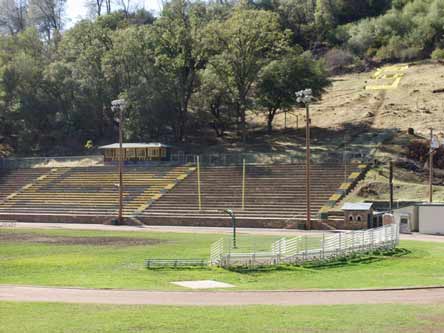9. Dunlavy Field — Sonora, Calif.

Dunlavy Field was built by the Works Progress Administration and reflects the natural environment around it.
Photo courtesy of Gray Brechin
Dunlavy Stadium, home of
Sonora (Calif.) football, grabs attention for where it is, who built it and when it was built.
The Great Depression-era Works Progress Administration constructed the stadium in the old Gold Rush mining town of Sonora, a couple hours east of San Francisco in the Sierra Nevada foothills. And they tucked the concrete bleachers (which used to have wood seatbacks) into an area that still features the ruggedness and beauty of the natural environment. Bright fall foliage, oak trees, creeks and a hill dominate the scenery at Dunlavy Stadium — not prefabricated metal bleachers and asphalt parking lots that are found at many other high school football stadiums.
"We all love that it is nestled behind a large hill and the sun drops behind it early in the evening, so even on the hottest days we have a shady field," head coach Bryan Craig said. "Coming
down from our locker room, hearing our band and the smell of barbecue in the
air, puts chills up my spine. This is my third year as head varsity
coach but my 21st year at
Sonora and I still get that feeling on game night."
The stadium, made of rock and concrete, was dedicated on Sept. 24, 1937 and capacity is about 5,000 people. Sonora's population is around 4,900.
All the fans sit on one side in the same concrete bleachers, and those fans also have to cross a footbridge over Wood Creek to get into the stadium.
Continue reading
